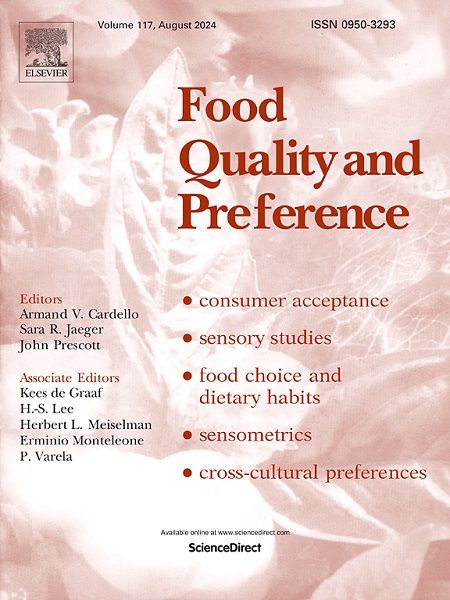法国消费者认为超加工食品营养质量差;无信息食品图像的分类研究
IF 4.9
1区 农林科学
Q1 FOOD SCIENCE & TECHNOLOGY
引用次数: 0
摘要
本研究通过两份在线问卷调查消费者如何根据食品的营养质量和加工程度对食品进行分类。200名法国消费者使用了一项定向分类任务,根据营养质量和加工程度对21张食品图像进行分类。这些图像不包含关于这两个特征或任何其他属性的信息。两次多项式logistic回归分析显示:(1)在没有获得加工程度或营养质量的既定值的情况下,参与者对食物图像的分类与这些既定值密切相关;(2)参与者对食品的营养质量分类也受到非营养性质的影响;(3)参与者在分类中将营养质量与加工程度联系起来。对于这种联系和所涉及的认知机制,提出了可能的原因,例如,由于饮食指南传达的信息过于简单而产生的学习联想,在缺乏信息的情况下使用启发式来克服估计食品营养质量的困难,以及健康光环效应。本文章由计算机程序翻译,如有差异,请以英文原文为准。
Ultra-processed foods are of poor nutritional quality in French consumers' representations; a categorization study of images of food products without information
This study investigated how consumers categorize food according to its nutritional quality and degree of processing through two online questionnaires. Two hundred French consumers used a directed sorting task to categorize 21 images of food products by nutritional quality and degree of processing. The images contained no information about these two characteristics or any other properties. Two multinomial logit regression analyses revealed that (1) without any access to established values for degree of processing or nutritional quality, participants' categorizations of food images closely mirrored these established values; (2) participants' categorization of food products by nutritional quality was also influenced by non-nutritional properties; (3) participants linked nutritional quality to degree of processing in their categorizations. Possible reasons are proposed for this link and the cognitive mechanisms involved, such as a learned association resulting from the overly simple messages conveyed by dietary guidelines, the use of heuristics to overcome the difficulty of estimating the nutritional quality of food products in the absence of information, and the health halo effect.
求助全文
通过发布文献求助,成功后即可免费获取论文全文。
去求助
来源期刊

Food Quality and Preference
工程技术-食品科技
CiteScore
10.40
自引率
15.10%
发文量
263
审稿时长
38 days
期刊介绍:
Food Quality and Preference is a journal devoted to sensory, consumer and behavioural research in food and non-food products. It publishes original research, critical reviews, and short communications in sensory and consumer science, and sensometrics. In addition, the journal publishes special invited issues on important timely topics and from relevant conferences. These are aimed at bridging the gap between research and application, bringing together authors and readers in consumer and market research, sensory science, sensometrics and sensory evaluation, nutrition and food choice, as well as food research, product development and sensory quality assurance. Submissions to Food Quality and Preference are limited to papers that include some form of human measurement; papers that are limited to physical/chemical measures or the routine application of sensory, consumer or econometric analysis will not be considered unless they specifically make a novel scientific contribution in line with the journal''s coverage as outlined below.
 求助内容:
求助内容: 应助结果提醒方式:
应助结果提醒方式:


